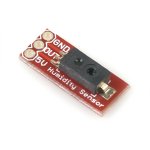Has anyone any experience of this humidity detector. Forum search revaled nothing.
I was given one, along with a Speakjet I.C. and a Sumo 14D by
my Sis in law visiting from the states. Better that duty free fags !!
Had a quick skim of the data sheet. Seems fairly straighforward but two things jumped out at me - Minimum load 80K and a bit of maths will be needed, Output / RH graph looks a bit Y=MX+C ish. Any experiences will be appreciated.
Russ
I was given one, along with a Speakjet I.C. and a Sumo 14D by
my Sis in law visiting from the states. Better that duty free fags !!
Had a quick skim of the data sheet. Seems fairly straighforward but two things jumped out at me - Minimum load 80K and a bit of maths will be needed, Output / RH graph looks a bit Y=MX+C ish. Any experiences will be appreciated.
Russ
Attachments
-
231.3 KB Views: 30
Last edited:

